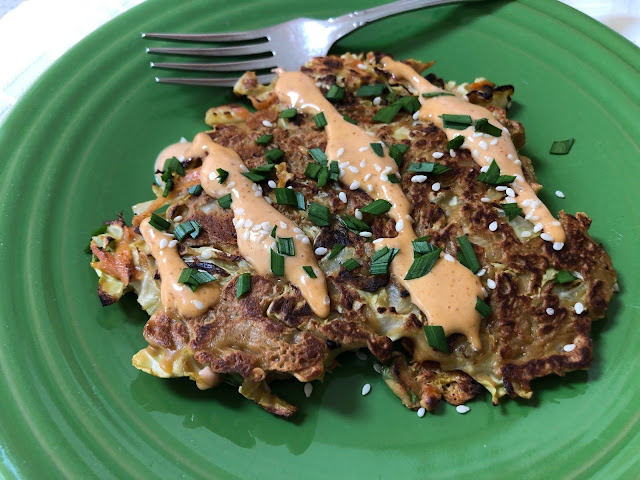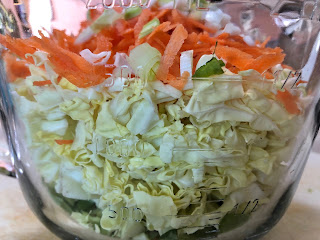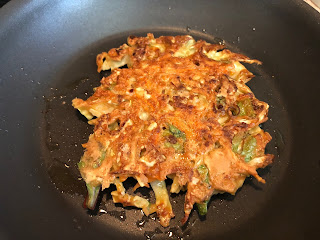
Recipe: Change up ingredients with whatever's on hand

(Photos: Kathy Morrison) |
Cabbage is not something I cook with often -- maybe twice a year. And since it's such a large vegetable, I invariably wind up with extra. We're not coleslaw fans in my house, and tossing still-edible vegetables into the compost bin is such a crime.
So I went searching for another good recipe and hit on several for okonomiyaki, or savory cabbage pancakes. The dish is Japanese in origin, the name derived from the word "okonomi," or roughly "what you like." These pancakes are designed to use up ingredients on hand, which makes it perfect for shelter-in-place cuisine -- no runs to the store for special ingredients these days.

If you don't have cabbage, try kale, full-size spinach, chard, shredded broccoli, bean sprouts or shredded zucchini. Also, if you don't have scallions, try green garlic -- which is what I used -- or garlic or regular chives.
Non-vegetarians also might want to toss in cubed leftover chicken or pork, cooked bacon or baby shrimp.
The garnish is flexible, too. The budgetbytes.com blog where I found the easiest recipe suggested a quick sauce of mayo and Sriracha, and a sprinkling of sesame seeds and chopped green onion. I subbed garlic chives for the green onion, but otherwise went with the mayo/Sriracha blend, which was terrific. Make it as spicy as you like.
The recipe I adapted here is for a smaller batch than many I found, but could be doubled easily. Any leftovers can be refrigerated and reheated, but you will lose the crispiness from the original cooking.
Another note: I tried cooking these in both a regular skillet and a non-stick one. Both produced well-crisped pancakes, but the non-stick pan cleaned up easier. So there is that.
Savory cabbage pancakes
Makes six or seven 6-inch pancakes
Ingredients:
4 to 5 cups shredded green cabbage (or other vegetable listed above)
1 large carrot
3 scallions or 1 stalk green garlic or 1/4 cup chopped fresh chives
3 large or 2 extra-large eggs
1/2 cup water
2 tablespoons soy sauce
1 tablespoon toasted sesame oil
3/4 to 1 cup all-purpose flour
2 tablespoons canola or vegetable oil, for frying

to a nice golden brown. |
Topping and garnish:
1/4 cup mayonnaise
1 tablespoon Sriracha sauce, or to taste
2 teaspoons sesame seeds (optional)
2 scallions or a handful of garlic chives, chopped (optional)
Instructions :
Remove wilted leaves from the cabbage, and cut out any core. If you have a full head of cabbage, cut it into quarters to make it easier to handle. Shred or thinly slice the cabbage until you have 4 to 5 cups of shreds. Peel and shred the carrot. Chop or slice the scallions (or green garlic or chives).
Whisk the eggs in a large bowl with the water, soy sauce and sesame oil. About 1/4 cup at a time, sprinkle in and whisk in the flour to form a thick, smooth batter. (Try to avoid dumping it in, which clumps the flour.)
Blend the cabbage, carrots and scallions into the batter until the vegetables are evenly coated with it.
Place a flat baking pan or heatproof serving plate in the oven at low heat (200 degrees is fine).
Heat 1/2 tablespoon of oil in a skillet (non-stick preferred) over medium heat. Measure out about 3/4 cup of the batter and add it to the heated pan, pressing it down to form a pancake about 6 inches in diameter and 1/2 inch thick.
Cook 3 to 5 minutes until the pancake is golden brown and crispy on the bottom. Turn down the heat if it's browning too quickly. Flip it over and cook the second side until equally brown.
Place the cooked pancake on the pan or plate in the warm oven; cover with foil if desired. Continue cooking pancakes in this manner, adding more oil to the pan as needed, until all the batter is used.
To serve, mix the mayo and Sriracha, and drizzle it over the pancakes as they're being plated, or pass it at the table. Sprinkle on the sesame seeds and chopped scallions or chives, if using.
Refrigerate any uneaten pancakes in a closed container; reheat in the microwave or oven.
Comments
0 comments have been posted.Sacramento Digs Gardening to your inbox.
Sites We Like
Garden Checklist for week of July 21
Your garden needs you!
* Keep your vegetable garden watered, mulched and weeded. Water before 8 a.m. to reduce the chance of fungal infection and to conserve moisture.
* Feed vegetable plants bone meal, rock phosphate or other fertilizers high in phosphate to stimulate more blooms and fruiting. (But wait until daily high temperatures drop out of the 100s.)
* Don’t let tomatoes wilt or dry out completely. Give tomatoes a deep watering two to three times a week.
* Harvest vegetables promptly to encourage plants to produce more. Squash especially tends to grow rapidly in hot weather. Keep an eye on zucchini.
* Pinch back chrysanthemums for bushy plants and more flowers in September.
* Remove spent flowers from roses, daylilies and other bloomers as they finish flowering.
* Pinch off blooms from basil so the plant will grow more leaves.
* Cut back lavender after flowering to promote a second bloom.
* It's not too late to add a splash of color. Plant petunias, snapdragons, zinnias and marigolds.
* From seed, plant corn, pumpkins, radishes, winter squash and sunflowers.